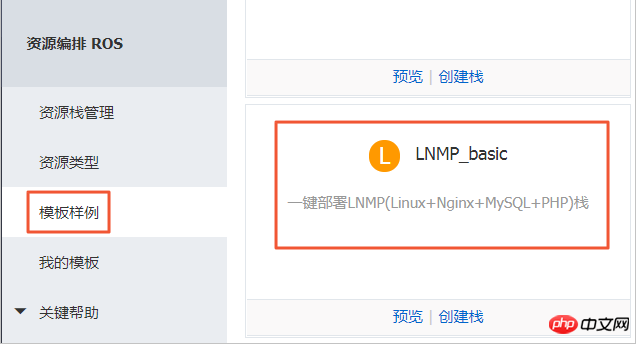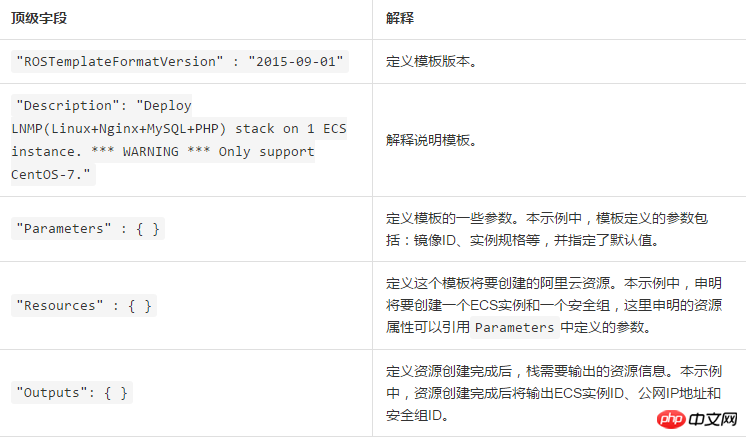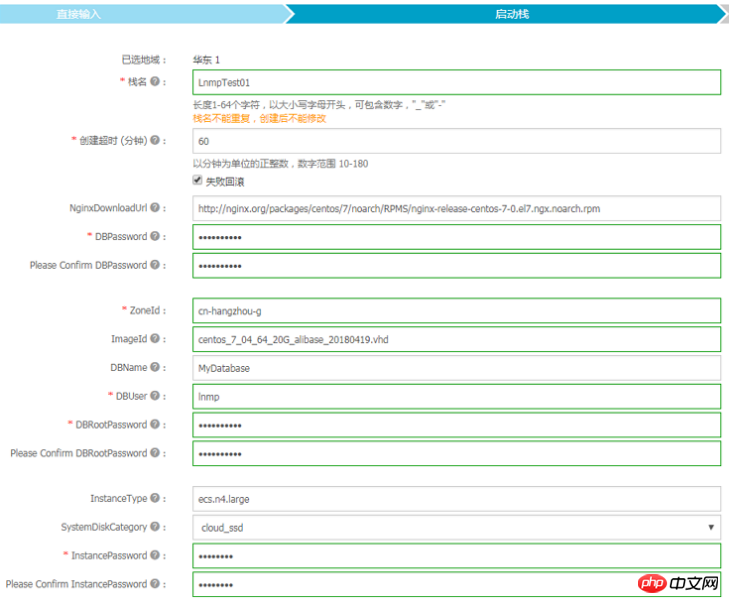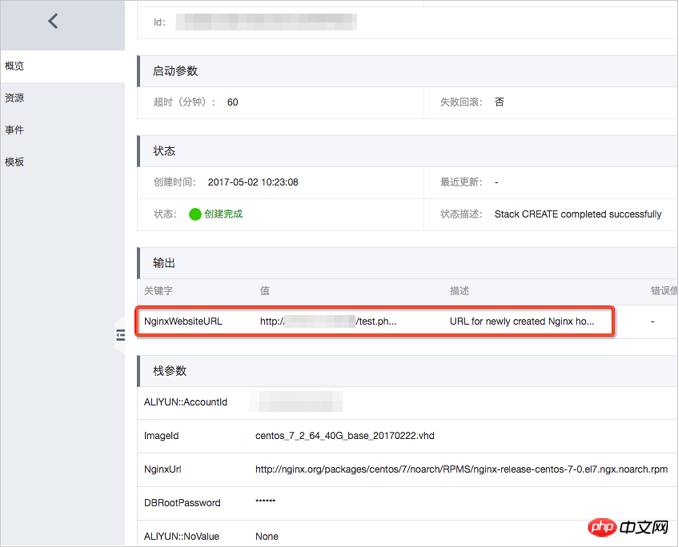 Operation and Maintenance
Operation and Maintenance
 Linux Operation and Maintenance
Linux Operation and Maintenance
 How to use Resource Orchestration Service (ROS) to build an LNMP environment on an ECS instance with one click
How to use Resource Orchestration Service (ROS) to build an LNMP environment on an ECS instance with one click
How to use Resource Orchestration Service (ROS) to build an LNMP environment on an ECS instance with one click
The content of this article is about how to use Resource Orchestration Service (ROS) to build an LNMP environment on an ECS instance with one click. It has certain reference value. Friends in need can refer to it. I hope it will be helpful to you. help.
One-click deployment of LNMP environment
LNMP represents Linux, Nginx, MySQL, and PHP respectively. This article introduces how to use Alibaba Cloud Resource Orchestration Service (ROS) to build an LNMP environment on an ECS instance with one click.
ROS is a free service provided by Alibaba Cloud’s official website and does not require downloading and installation. You can use ROS to create a resource stack template file in JSON format, or use the template sample provided by ROS to create a set of Alibaba Cloud resources. In this tutorial, we will use the LNMP_basic template provided by the ROS console to automatically create an ECS instance and deploy the LNMP environment on the instance.
Prerequisites
When creating pay-as-you-go resources, the account balance cannot be less than 100.00 yuan, which can be cash, available credit limit or available Vouchers for opening products.
Operation steps
Log in to the ROS management console.
Note: If you are using ROS for the first time, you must first activate the ROS service. ROS services are free, and there are no fees for activating the services.
In the left navigation bar, select Key Help > ECS instance related information to obtain the ECS instance specifications, availability zone ID (ZoneId), and image ID (ImageId) you need.
In the left navigation bar, click Template Sample.
From the template sample, find LNMP_basic.

Click the Preview button to view the JSON file of the template. The explanation of each top-level field of the JSON file is shown in the following table.

Note: For more information about the ROS resource stack template, please see the template structure description of Resource Orchestration.
Click to create a Stack.
In the direct input section, select the specific region in the drop-down box of region, and click Next in the lower right corner of the page. In this example, choose China East 2.
In the startup stack section, set parameters:
Stack name: Set a stack name, which cannot be repeated and cannot be modified after creation.
Creation timeout: Set a time. If the resource is not successfully created within the set time period, the judgment will time out. You can choose whether to rollback on failure. If you choose rollback on failure, if any failure occurs during the creation process (including creation timeout), ROS will delete the successfully created resources.
NginxDownloadUrl: Use the default Nginx download address.
DBPassword and Please Confirm DBPassword: Set and confirm the password to access the MySQL database. According to the template definition, the password can only contain English letters and numbers.
ZoneId: Fill in the availability zone where you need to create resources. See step 2 for details.
DBUser: Create a user to access the MySQL database.
DBRootPassword and Please Confirm DBRootPassword: Set and confirm the password of the MySQL root account. According to the template definition, the password can only contain English letters and numbers.
InstanceType: Fill in the ECS instance specifications you need. See step 2 for details.
SystemDiskCategory: Select the cloud disk type as the system disk.
InstancePassword and Please Confirm InstancePassword: Set and confirm the login password for the instance. According to the template definition, the password can only contain uppercase or lowercase English letters and numbers.

Click Create, and the page will prompt that the creation request was submitted successfully.
In the left navigation bar, click Resource Stack Management to view the status of the stack. When the stack is successfully created, view the NginxWebsiteURL defined in Outputs in the Output section. You can access the created LNMP environment through this address.

Instructions:
View all resources in the stack in the resource list.
View the operation records generated by ROS in the process of creating this resource stack in the event list. If any operation involving the resource stack fails, the reason for the resource operation failure will be displayed in the list.
View the original template of the resource stack in the template list.
The above is the detailed content of How to use Resource Orchestration Service (ROS) to build an LNMP environment on an ECS instance with one click. For more information, please follow other related articles on the PHP Chinese website!

Hot AI Tools

Undresser.AI Undress
AI-powered app for creating realistic nude photos

AI Clothes Remover
Online AI tool for removing clothes from photos.

Undress AI Tool
Undress images for free

Clothoff.io
AI clothes remover

Video Face Swap
Swap faces in any video effortlessly with our completely free AI face swap tool!

Hot Article

Hot Tools

Notepad++7.3.1
Easy-to-use and free code editor

SublimeText3 Chinese version
Chinese version, very easy to use

Zend Studio 13.0.1
Powerful PHP integrated development environment

Dreamweaver CS6
Visual web development tools

SublimeText3 Mac version
God-level code editing software (SublimeText3)

Hot Topics
 1660
1660
 14
14
 1416
1416
 52
52
 1310
1310
 25
25
 1260
1260
 29
29
 1233
1233
 24
24
 Linux Architecture: Unveiling the 5 Basic Components
Apr 20, 2025 am 12:04 AM
Linux Architecture: Unveiling the 5 Basic Components
Apr 20, 2025 am 12:04 AM
The five basic components of the Linux system are: 1. Kernel, 2. System library, 3. System utilities, 4. Graphical user interface, 5. Applications. The kernel manages hardware resources, the system library provides precompiled functions, system utilities are used for system management, the GUI provides visual interaction, and applications use these components to implement functions.
 vscode terminal usage tutorial
Apr 15, 2025 pm 10:09 PM
vscode terminal usage tutorial
Apr 15, 2025 pm 10:09 PM
vscode built-in terminal is a development tool that allows running commands and scripts within the editor to simplify the development process. How to use vscode terminal: Open the terminal with the shortcut key (Ctrl/Cmd). Enter a command or run the script. Use hotkeys (such as Ctrl L to clear the terminal). Change the working directory (such as the cd command). Advanced features include debug mode, automatic code snippet completion, and interactive command history.
 How to check the warehouse address of git
Apr 17, 2025 pm 01:54 PM
How to check the warehouse address of git
Apr 17, 2025 pm 01:54 PM
To view the Git repository address, perform the following steps: 1. Open the command line and navigate to the repository directory; 2. Run the "git remote -v" command; 3. View the repository name in the output and its corresponding address.
 Where to write code in vscode
Apr 15, 2025 pm 09:54 PM
Where to write code in vscode
Apr 15, 2025 pm 09:54 PM
Writing code in Visual Studio Code (VSCode) is simple and easy to use. Just install VSCode, create a project, select a language, create a file, write code, save and run it. The advantages of VSCode include cross-platform, free and open source, powerful features, rich extensions, and lightweight and fast.
 vscode terminal command cannot be used
Apr 15, 2025 pm 10:03 PM
vscode terminal command cannot be used
Apr 15, 2025 pm 10:03 PM
Causes and solutions for the VS Code terminal commands not available: The necessary tools are not installed (Windows: WSL; macOS: Xcode command line tools) Path configuration is wrong (add executable files to PATH environment variables) Permission issues (run VS Code as administrator) Firewall or proxy restrictions (check settings, unrestrictions) Terminal settings are incorrect (enable use of external terminals) VS Code installation is corrupt (reinstall or update) Terminal configuration is incompatible (try different terminal types or commands) Specific environment variables are missing (set necessary environment variables)
 vscode Previous Next Shortcut Key
Apr 15, 2025 pm 10:51 PM
vscode Previous Next Shortcut Key
Apr 15, 2025 pm 10:51 PM
VS Code One-step/Next step shortcut key usage: One-step (backward): Windows/Linux: Ctrl ←; macOS: Cmd ←Next step (forward): Windows/Linux: Ctrl →; macOS: Cmd →
 What is the main purpose of Linux?
Apr 16, 2025 am 12:19 AM
What is the main purpose of Linux?
Apr 16, 2025 am 12:19 AM
The main uses of Linux include: 1. Server operating system, 2. Embedded system, 3. Desktop operating system, 4. Development and testing environment. Linux excels in these areas, providing stability, security and efficient development tools.
 How to run sublime after writing the code
Apr 16, 2025 am 08:51 AM
How to run sublime after writing the code
Apr 16, 2025 am 08:51 AM
There are six ways to run code in Sublime: through hotkeys, menus, build systems, command lines, set default build systems, and custom build commands, and run individual files/projects by right-clicking on projects/files. The build system availability depends on the installation of Sublime Text.



